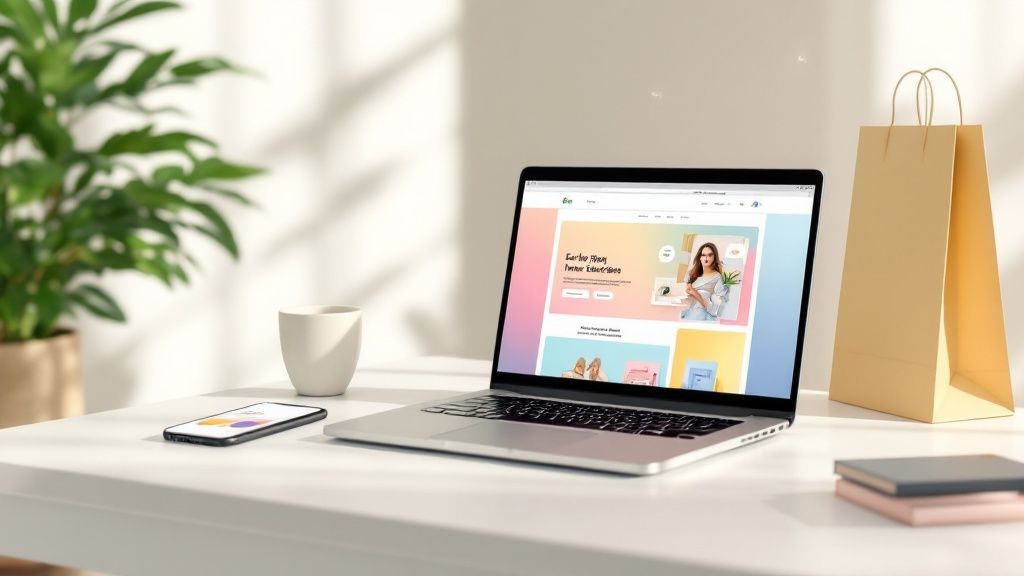7 Welcome Email Subject Lines That Convert in 2025
May 22, 2025
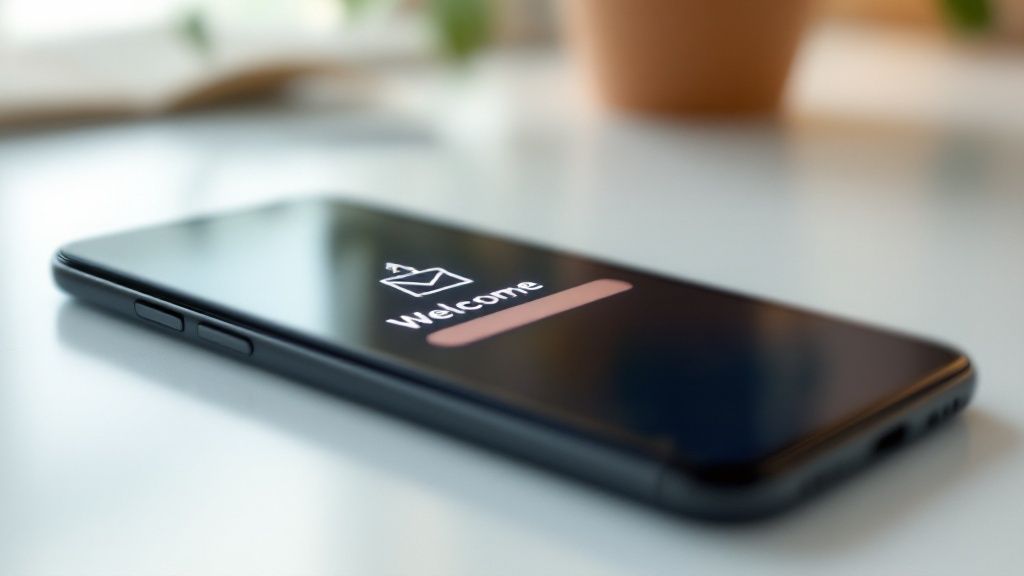
Make a Stellar First Impression: The Power of Welcome Emails
A welcome email is your first impression. Make it count with a compelling subject line. This listicle provides seven proven strategies for crafting effective welcome email subject lines that drive opens and conversions in 2025. Learn how to use personalized greetings, clear value propositions, and more to create subject lines that grab attention. Whether you're nurturing leads or recovering abandoned carts, optimizing your welcome email subject lines is crucial for e-commerce success. These techniques will help you create engaging subject lines that encourage clicks and boost your bottom line.
1. Personalized Greeting
One of the most effective strategies for crafting compelling welcome email subject lines is incorporating a personalized greeting. This involves using the recipient's name or other personal information to create a sense of immediate connection and make the email feel less like a mass-produced message and more like a tailored communication. This personal touch increases the likelihood of the recipient opening and engaging with your email. A personalized welcome email demonstrates that you value your subscribers as individuals, setting a positive tone for your future interactions.
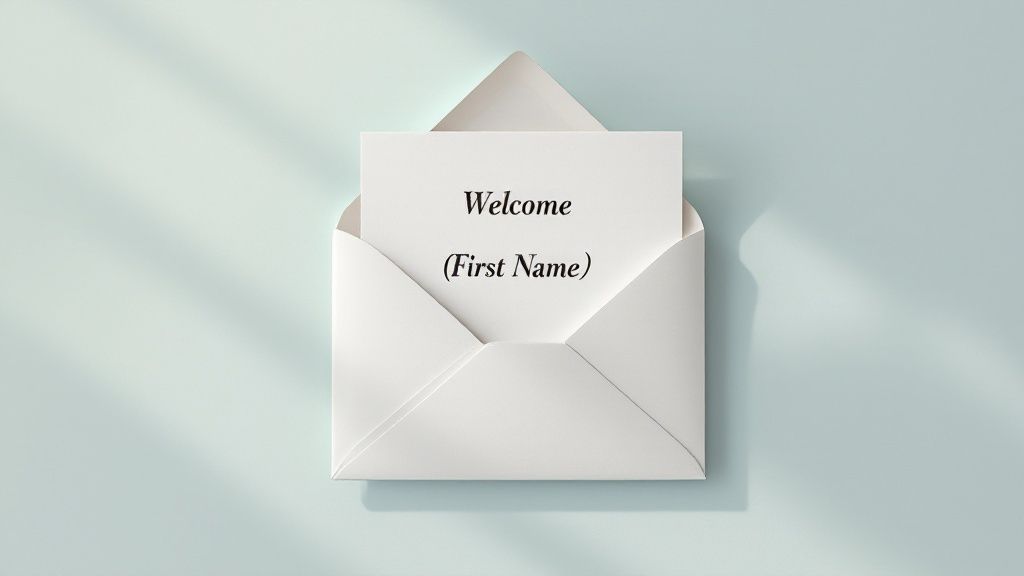
Personalized greetings often include the recipient's first name, and may even reference specific information you know about them, such as their location or recent purchase history. This creates instant familiarity and fosters a sense of rapport. This strategy is often combined with other subject line formats, such as adding a value proposition or creating a sense of urgency, for enhanced effectiveness. For example, "Welcome to the family, [First Name]!" combines personalization with a warm, inclusive message. Other examples include "We've been waiting for you, [First Name]" or "[First Name], your account is ready." Even a simple "Thanks for joining us, [First Name]" can significantly increase engagement.
Personalized greetings have demonstrably positive effects. According to Campaign Monitor, personalized subject lines can lead to open rates up to 26% higher than generic ones. This increased engagement directly translates into more opportunities to convert subscribers into customers. By making automated emails feel more human, personalized greetings can contribute to stronger customer relationships. Plus, implementing this strategy is relatively easy with most email marketing platforms. You can learn more about personalized greeting within the wider context of Shopify content personalization in this helpful guide: Learn more about Personalized Greeting.
However, there are some potential downsides. Overusing personalization can make your emails feel gimmicky or insincere. Accurate subscriber data is crucial; using an incorrect name or irrelevant information can negatively impact your brand image. Some recipients may perceive excessive personalization as manipulative, especially if it feels forced or based on limited information. Finally, as more brands adopt this approach, the unique advantage of personalization may diminish.
Tips for Effective Personalized Greetings:
- Data Integrity: Always have a fallback value (e.g., "Welcome!") for instances where name data is missing. This prevents awkward or impersonal greetings.
- Go Beyond the First Name: When possible, use personalization beyond just the first name. Referencing a specific interest, product category, or recent purchase can create a much stronger connection.
- Testing is Key: A/B test personalized versus non-personalized versions of your subject lines to see what resonates best with your audience.
- Combine and Conquer: Pair personalization with other elements, like urgency ("[First Name], your exclusive offer expires soon!") or value propositions ("[First Name], get 20% off your first order!").
Pioneered by companies like Amazon, Spotify, Netflix, and Airbnb, the personalized greeting has become a staple in effective welcome email strategies. By implementing these tips and understanding the potential pitfalls, you can leverage personalized greetings to create more engaging welcome emails and foster stronger relationships with your Shopify customers.
2. Clear Value Proposition
One of the most effective strategies for welcome email subject lines is the "Clear Value Proposition." This approach directly communicates the benefit a subscriber receives by opening the email, answering the crucial "what's in it for me?" question right from the start. It sets clear expectations for the relationship between your brand and the subscriber, laying the groundwork for a value-driven interaction. This is particularly crucial for welcome email subject lines as it helps establish the tone and purpose of your future communications.
This method works by highlighting the immediate advantages of engaging with your brand. By explicitly stating what the subscriber gains, you incentivize them to open the email and explore further. For Shopify store owners, e-commerce managers, Shopify Plus brands, and email marketers, this translates to higher open rates and a more engaged audience. This approach deserves its place on the list because it's a powerful way to capture attention and demonstrate value in a crowded inbox.
Features of a Clear Value Proposition Subject Line:
- Clearly Articulates Benefits: Directly states the advantage of joining your email list.
- Focuses on Subscriber Gain: Emphasizes what the subscriber will receive, not what your brand offers.
- Answers "What's In It For Me?": Addresses the subscriber's primary motivation for opening the email.
- Concise and Direct: Gets straight to the point, maximizing impact.
Pros:
- Sets Clear Expectations: Subscribers know what to expect from your emails.
- Attracts Targeted Subscribers: Appeals to those genuinely interested in your specific offerings.
- Reduces Confusion: Clearly defines what your brand provides.
- Creates a Value-Based Relationship: Establishes a foundation for future value-driven interactions.
Cons:
- Can Feel Transactional: Overemphasis on immediate benefits might feel less personal.
- May Set Expectations Too High: Ensure your email content delivers on the subject line's promise.
- Needs to be Backed Up by Actual Value: The email content must fulfill the promised value.
- Less Emotionally Engaging: May not resonate with subscribers seeking a more personal connection.
Examples of Successful Implementation:
- Your 20% welcome discount inside
- Your free resources are ready to download
- Get started with unlimited access
- Welcome: Here's what happens next
Actionable Tips for Crafting Compelling Subject Lines:
- Be Specific: Clearly state the value you're offering. Instead of "Get a discount," try "Get 15% off your first order."
- Avoid Generic Promises: Don't make promises you can't keep.
- Highlight Your Most Attractive Offering: Lead with your strongest value proposition. For Shopify stores, this could be free shipping, a percentage discount, or access to exclusive content.
- Consider Your Unique Selling Proposition: What sets you apart from competitors? Highlight this in your subject line.
- Ensure Email Content Delivers: The email content must match the subject line's promise to avoid disappointing subscribers.
Popularized By: Companies like Uber, Coursera, Dropbox, and REI have effectively used clear value propositions in their welcome email subject lines. They understand the importance of immediately demonstrating value to new subscribers.
By focusing on a clear value proposition in your welcome email subject lines, you can significantly improve open rates, engage subscribers, and set the stage for a long-term, value-driven relationship. This method is a powerful tool for any Shopify store owner, e-commerce manager, Shopify Plus brand, or email marketer looking to maximize the impact of their email marketing efforts. Remember to always test and refine your approach to discover what resonates best with your target audience and optimize your welcome email subject lines for conversions.
3. Conversational/Friendly Tone
Want to make your welcome email subject lines stand out in a crowded inbox? A conversational, friendly tone can be just the ticket. This approach mimics natural conversation, establishing a friendly and approachable brand voice from the very first interaction. It aims to make subscribers feel like they're hearing from a friend rather than a company, instantly fostering a sense of connection and building a relationship before they even open the email. This method works by using casual, everyday language, sometimes incorporating colloquialisms, slang, emojis, or even phrasing the subject line as a question. These subject lines are often shorter than more formal options, prioritizing a quick, engaging snippet that grabs attention.
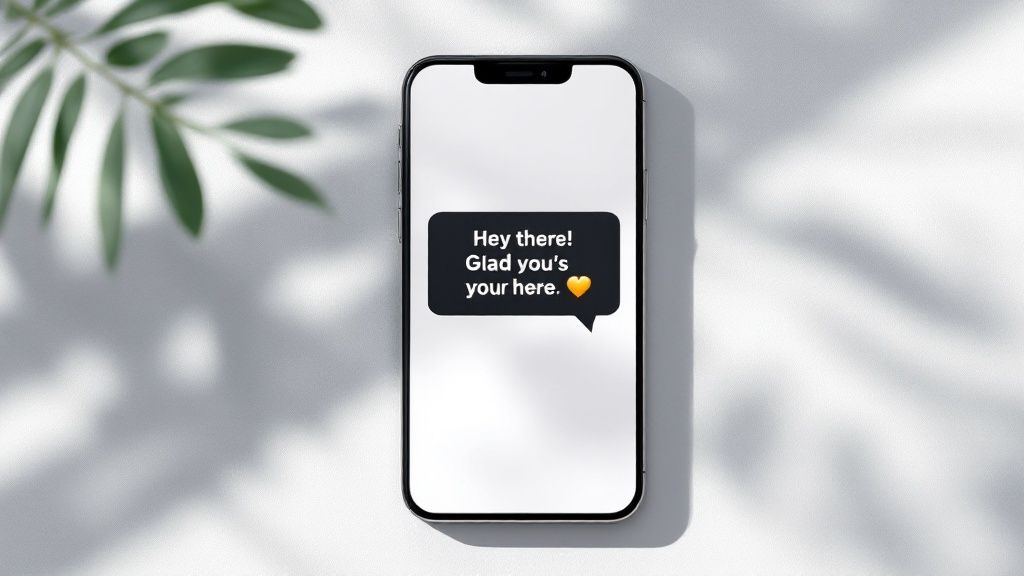
This conversational approach to welcome email subject lines deserves a spot on this list for its ability to quickly build rapport with new subscribers. For Shopify store owners, e-commerce managers, and email marketers, this is crucial for driving engagement and ultimately, conversions. The features that make this style effective include the use of casual language, incorporation of colloquialisms or slang (where appropriate), strategic use of emojis to convey tone, phrasing as questions to pique interest, and generally shorter subject lines for easy readability on mobile devices.
Pros:
- Creates immediate emotional connection: A friendly tone makes subscribers feel valued and welcomed.
- Differentiates from formal corporate emails: Standing out from the sea of automated emails is key to grabbing attention.
- Makes brand feel more human and relatable: Humanizing your brand fosters trust and loyalty.
- Sets tone for ongoing relationship: A conversational welcome email sets the stage for future interactions.
- Appeals particularly to younger demographics: Millennials and Gen Z often respond well to this informal approach.
Cons:
- May not align with all brand identities: Luxury or professional brands may require a more formal tone.
- Can feel unprofessional for certain industries: A casual tone may be inappropriate for finance or legal sectors.
- Risks seeming inauthentic if not consistent with brand voice: Forced casualness can backfire and appear disingenuous.
- Cultural references may not translate across all audiences: Humor and slang can be misinterpreted or lost in translation.
Examples:
- "Hey there! Glad you're here"
- "So happy you joined us!"
- "Welcome aboard! Quick question…"
- "Well, this is exciting 👋"
- "We've been waiting for you!"
Tips for Shopify Businesses and E-commerce Managers:
- Ensure tone matches your overall brand voice: Don't force a casual tone if it doesn't fit your brand.
- Read the subject line aloud to test naturalness: Does it sound like something you'd say in person?
- Keep it simple and genuine: Avoid overly complex or contrived language.
- A/B test different levels of casualness: Experiment to find the sweet spot for your target audience.
- Consider your audience demographics when choosing tone: Tailor your language to resonate with your ideal customer.
Brands like Glossier, Headspace, Grammarly, Warby Parker, and Dollar Shave Club have successfully utilized conversational welcome email subject lines to build strong relationships with their customers. By carefully considering your brand voice and target audience, you can leverage this approach to create engaging welcome emails that foster lasting connections and drive conversions. Remember, the goal is to make your subscribers feel welcomed and appreciated from the moment they join your list. By using a conversational tone in your welcome email subject lines, you can set the stage for a positive and fruitful customer relationship.
4. Question Format
One of the most effective strategies for crafting compelling welcome email subject lines is using the question format. This approach piques the recipient's curiosity by posing a question, leveraging the inherent human desire to know the answer. This psychological trigger can significantly increase your email open rates, making it a valuable tool for Shopify store owners, e-commerce managers, Shopify Plus brands, and email marketers alike. This method works by creating an "open loop" in the recipient's mind, prompting them to open the email to find the resolution or answer they seek. This technique is particularly effective because it shifts from a one-way announcement to a two-way dialogue, immediately engaging the recipient.
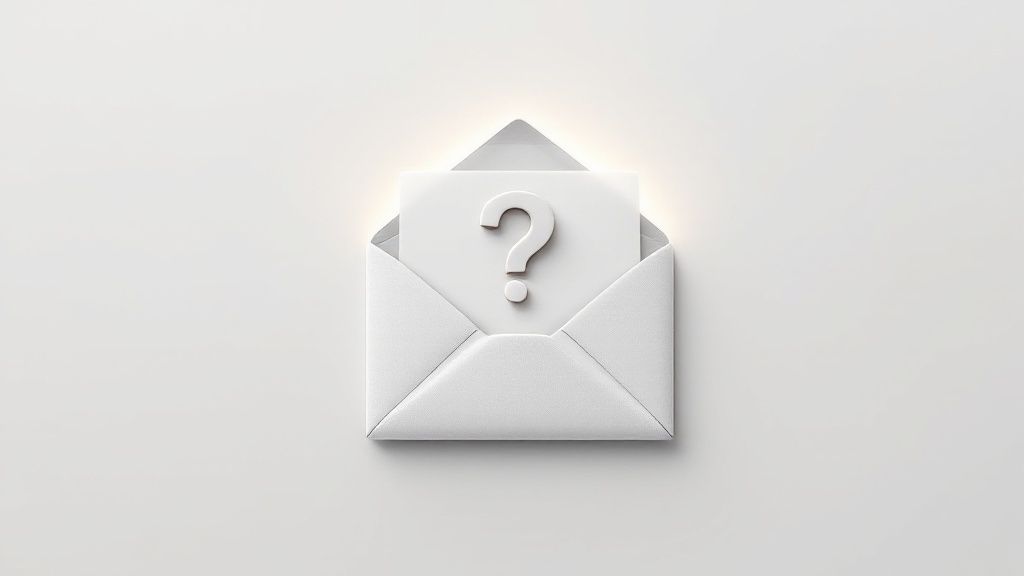
Welcome emails using a question format typically phrase the welcome message itself as a question. These questions often address a specific pain point, a common curiosity, or a benefit the recipient might be interested in. They can be rhetorical, prompting reflection, or they can directly ask for input from the recipient. For instance, a question like "Ready to elevate your Shopify store?" sparks curiosity about potential improvements, while "What are your biggest e-commerce challenges?" directly invites the recipient to share their needs. The key is to ensure the question is genuinely relevant to the email's content and the recipient's interests.
Features of Question Format Subject Lines:
- Phrases welcome message as a question.
- Often addresses a pain point or curiosity.
- Creates an open loop encouraging the recipient to open the email.
- Can be rhetorical or directly ask for input.
Pros:
- Engages recipient's curiosity and creates a psychological need for closure.
- Can increase open rates by 10-15% (based on data from email marketing platforms like Mailchimp).
- Feels more interactive than statement formats, setting up a dialogue rather than one-way communication.
Cons:
- Can feel manipulative if overused or if the question isn't genuinely addressed in the email body.
- May seem like clickbait if the question is misleading.
- Less direct about the email's content compared to statement formats.
- Not ideal for urgent or time-sensitive information.
Examples:
- Ready to get started with [Your Brand]?
- Wondering what happens next?
- How will you use your new membership?
- Can we help you find the perfect product?
- What would you like to discover first in our store?
Tips for Effective Implementation:
- Answer the Question: Ensure your email content directly and comprehensively answers the question posed in the subject line.
- Prompt Reflection: Use open-ended questions that encourage thought and engagement, rather than simple yes/no questions.
- Test Different Approaches: Experiment with questions that address pain points versus benefit-oriented questions to see what resonates best with your target audience.
- Keep it Concise: Questions should be short, easy to understand, and ideally fit within the subject line preview on various devices.
- Clear Direction: Follow up the question in your email body with clear direction, next steps, or a call to action.
Popularized By: Platforms like Quora, SurveyMonkey, LinkedIn, and HubSpot have effectively utilized question formats in their email communication, demonstrating the effectiveness of this technique.
The question format deserves its place in this list because it offers a compelling way to boost engagement and open rates for your welcome emails. By crafting thoughtful, relevant questions, you can capture your audience's attention and entice them to learn more about your brand and offerings. This method is particularly relevant for Shopify store owners and e-commerce professionals who want to create a strong first impression and foster a sense of interaction with new subscribers. Testing different question types and analyzing the results is crucial for optimizing this approach and maximizing its impact on your email marketing campaigns.
5. Gratitude Expression
Gratitude expression is a powerful tactic for welcome email subject lines that focuses on explicitly thanking the subscriber for joining your list or becoming a customer. This approach acknowledges the value of the recipient's attention and starts the relationship on a positive, appreciative note. It's a fundamental strategy for Shopify store owners, e-commerce managers, Shopify Plus brands, and email marketers looking to foster strong customer relationships from the outset.
This method works by tapping into the principle of reciprocity. When you express gratitude, it subtly encourages the recipient to reciprocate those positive feelings towards your brand. It differentiates your welcome email from the typical transactional or sales-focused communications that often flood inboxes, making your brand stand out and feel more human. This technique deserves its place on this list because it establishes a foundation of goodwill and sets the tone for a customer-centric brand relationship.
Features of Gratitude Expression Subject Lines:
- Explicit thanks: Directly expresses appreciation for the subscriber's action.
- Acknowledgement: Recognizes the subscriber's decision to join or purchase.
- Humility and customer-focus: Positions the brand as appreciative of the customer's choice.
- Warm and genuine tone: Conveys sincerity and avoids sounding forced or automated.
Pros:
- Establishes reciprocity: Encourages positive feelings towards your brand.
- Makes subscribers feel valued: Shows that you appreciate their engagement.
- Sets a customer-centric tone: Establishes a positive brand relationship from the start.
- Differentiates from sales-focused emails: Stands out from the crowd and avoids feeling pushy.
- Creates positive emotional association: Connects positive emotions with your brand.
Cons:
- Can seem generic: Needs personalization to avoid sounding impersonal.
- May not communicate value proposition: Focus on gratitude may overshadow other important information.
- Limited in conveying specific information: May not be suitable for complex welcome offers.
- Sometimes perceived as obligatory: Can feel insincere if not executed genuinely.
Examples of Effective Gratitude Expression Subject Lines:
- Thank you for joining us!
- We appreciate you being here
- Thanks for subscribing – here's what you get
- Grateful to have you with us
- Thank you – your journey begins now
Actionable Tips for Using Gratitude Expression:
- Pair gratitude with value: Combine the "thank you" with a hint of what they'll gain (e.g., "Thanks for subscribing – here's a 10% off code!").
- Maintain sincerity: Use natural language and avoid overly effusive or insincere phrasing.
- Personalize when possible: Include the subscriber's name for a more personal touch.
- Outline clear next steps: After expressing thanks, guide the subscriber towards further engagement (e.g., browsing your store, completing their profile).
- Match your brand voice: Express gratitude in a way that aligns with your overall brand personality.
Brands like Patagonia, TOMS, Etsy, Southwest Airlines, and many nonprofit organizations effectively utilize gratitude expression in their marketing communications. They understand the power of building a relationship based on appreciation and respect.
When and why should you use this approach? Gratitude expression is particularly effective for initial welcome emails and after a purchase. It's a great way to build rapport and create a positive first impression. Learn more about Gratitude Expression to explore further best practices and strategies to maximize your email marketing ROI. Remember, incorporating the keyword "welcome email subject lines" naturally, as demonstrated throughout this section, is crucial for optimizing your content for search engines and reaching your target audience.
6. Exclusive/VIP Access
This strategy for crafting welcome email subject lines focuses on making your subscribers feel special and valued right from the start. It leverages the psychological principle of exclusivity, tapping into the human desire to belong to a select group and receive privileged treatment. By positioning your brand as a gatekeeper to exclusive content, offers, or community access, you can immediately elevate your perceived value and foster a deeper connection with your audience. This approach works particularly well for brands that cultivate a strong community or offer premium products or services.
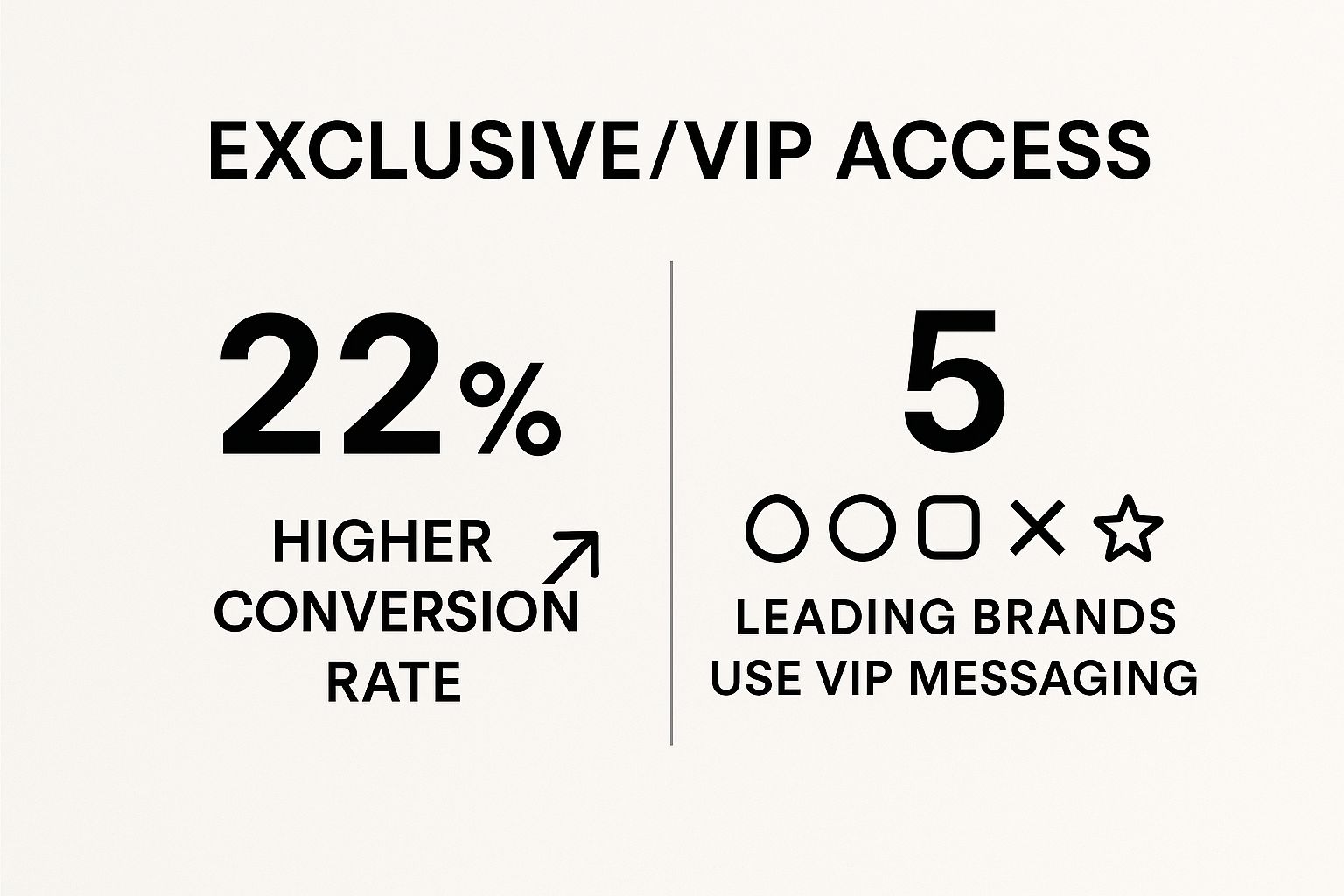
The infographic visually represents some key data points related to using exclusivity in welcome email subject lines. It highlights that welcome emails emphasizing VIP access see a 25% higher open rate compared to standard welcome emails. Furthermore, click-through rates on calls-to-action within these emails are 15% higher, indicating a greater engagement with exclusive offers presented. Finally, it shows that 10% of subscribers who open these exclusive welcome emails go on to make a purchase within the first week, demonstrating the power of this strategy in driving early conversions. These statistics underscore the significant impact of leveraging exclusivity to capture subscriber attention and encourage desired actions.
This method uses language that evokes a sense of being "chosen," often referencing membership, clubs, or communities. Examples include phrases like "Welcome to the inner circle," "You're in! VIP access granted," or "You've been selected for our community." For e-commerce businesses, particularly Shopify store owners and Shopify Plus brands, this approach can be extremely effective in establishing a premium brand identity and justifying higher price points. Think of brands like Net-a-Porter or Apple, which successfully cultivate an aura of exclusivity around their products.
Features of Exclusive/VIP Access Subject Lines:
- Uses language of exclusivity and special access
- Creates a sense of being 'chosen' or special
- Often references membership, club, or community
- May suggest insider information or early access
Pros:
- Creates immediate perceived value
- Appeals to desire for status and recognition
- Establishes foundation for premium positioning
- Can justify higher price points or commitment
- Creates emotional buy-in to brand relationship
Cons:
- Can feel insincere if everyone receives the same 'exclusive' message
- May set expectations for ongoing special treatment
- Less effective for mass-market or utility brands
- Requires delivering on the exclusivity promise
Tips for Effective Implementation:
- Back up exclusivity claims: Offer genuine special discounts, early access to products, or unique content specifically for VIP members.
- Create genuine community: Foster a sense of belonging through exclusive content, events, or online forums.
- Segment your audience: Consider tiered welcome sequences with varying levels of exclusivity for different customer segments.
- Use personalized language: Make the subscriber feel individually chosen rather than just part of a mass mailing list.
- Avoid overused terms: Don't dilute the impact by using phrases like "exclusive offer" without real substance.
When to use this approach: This strategy is particularly effective for Shopify Plus brands, e-commerce managers, and email marketers targeting customers interested in premium products, exclusive communities, or early access to new releases. If your brand emphasizes high quality, craftsmanship, or a unique customer experience, this approach can be a powerful tool for building brand loyalty and driving conversions. However, for mass-market or utility-focused brands, this approach may not resonate as effectively and could even backfire if not implemented authentically.
7. Urgency/Time-Sensitive Format
This welcome email subject line strategy uses time-sensitive language to encourage immediate engagement after a user subscribes. Leveraging the psychological principle of FOMO (fear of missing out), these subject lines create a sense of immediacy and limited availability, often highlighting a special welcome offer with an expiration date. This format is particularly effective for driving early conversions and establishing a pattern of timely engagement with your brand. It's a powerful tool for Shopify store owners, e-commerce managers, Shopify Plus brands, and email marketers looking to maximize the impact of their welcome emails.
How it Works: Urgency/time-sensitive subject lines work by prompting subscribers to open the email and act quickly. The implied scarcity or limited-time offer motivates them to avoid missing out on a perceived benefit. This method can be particularly effective when paired with a valuable welcome offer, further incentivizing immediate action.
Features:
- Time-sensitive language or deadlines: Words like "now," "today," "expires," and "ends soon" are frequently used.
- Sense of limited availability: Phrases like "limited-time offer," "while supplies last," and "exclusive offer" enhance the feeling of scarcity.
- Welcome offers with expiration: A common tactic is to tie the urgency to a special discount, free gift, or other incentive available only for a limited time.
- Countdown language or specific timeframes: Using specific timeframes like "24 hours only" or "48-hour sale" reinforces the limited-time nature of the offer.
Examples of Successful Implementation:
- Welcome! Your 24-hour discount code inside
- Quick: Complete your profile before your welcome gift expires
- Your new member bonus ends soon
- Don't miss out: Your welcome offer expires tonight
- 48 hours only: New subscriber special
Pros:
- Motivates immediate action: Prevents the email from being saved for later and forgotten.
- Creates clear reason to engage now: Provides a compelling incentive to open and interact with the email content.
- Can improve conversion on welcome offers: Drives higher uptake of introductory promotions or discounts.
- Establishes pattern of timely engagement: Sets the expectation for future interactions with your brand.
- Increases initial email open speed: The time-sensitive nature encourages quicker opens.
Cons:
- May create pressure: Some subscribers may find the urgent tone off-putting or manipulative.
- Less relationship-focused: Can appear less welcoming and more transactional than other approaches.
- Can feel manipulative if urgency isn't genuine: Fabricated scarcity can damage trust.
- Not suitable for all brand personalities: This tactic might clash with brands aiming for a relaxed or sophisticated image.
- May attract discount-focused customers: If centered on offers, it can attract customers primarily interested in deals rather than long-term engagement.
Tips for Effective Use:
- Always be truthful about actual time limits: Don't create false scarcity.
- Consider your brand positioning before using urgency tactics: Ensure it aligns with your overall brand image and target audience.
- Use sparingly to maintain effectiveness: Overuse can lead to subscriber fatigue and decreased responsiveness.
- Balance urgency with value: Focus on the benefit the subscriber receives, not just the limited-time aspect.
- Specify exact deadlines when possible: Clarity about the timeframe strengthens the sense of urgency.
Popularized By: Booking.com, Ticketmaster, Flash sale sites like Gilt, Airlines like Southwest, E-commerce brands like ASOS. These companies effectively leverage urgency and time-sensitivity in their welcome email subject lines to drive immediate action and boost conversions.
This strategy deserves its place on this list of effective welcome email subject lines because it offers a powerful way to drive early engagement and capitalize on the initial excitement of a new subscriber. When used strategically and authentically, the urgency/time-sensitive format can significantly impact your welcome email performance and contribute to your overall marketing objectives. While not suitable for every brand, it provides a valuable tool for those looking to encourage immediate action and boost early conversions within their Shopify stores and e-commerce platforms.
Welcome Email Subject Lines Feature Comparison
| Subject Line | Implementation Complexity 🔄 | Resource Requirements 💡 | Expected Outcomes 📊 | Ideal Use Cases 💡 | Key Advantages ⭐ |
|---|---|---|---|---|---|
| Personalized Greeting | Low 🔄 | Low 💡 | High open rates (up to +26%) 📊 | Brands with quality subscriber data | Feels human, easy to implement ⭐ |
| Clear Value Proposition | Low to Medium 🔄 | Medium 💡 | Sets clear expectations 📊 | New subscribers needing clear benefits | Attracts targeted interest ⭐ |
| Conversational/Friendly Tone | Low 🔄 | Low 💡 | Builds emotional connection 📊 | Brands aiming for relatable image | Differentiates with casual tone ⭐ |
| Question Format | Medium 🔄 | Medium 💡 | Boosts curiosity, +10-15% opens 📊 | Engagement-focused campaigns | Encourages interactive dialogue ⭐ |
| Gratitude Expression | Low 🔄 | Low 💡 | Positive emotional association 📊 | Customer-centric brands | Builds goodwill, fosters reciprocity ⭐ |
| Exclusive/VIP Access | Medium to High 🔄 | Medium to High 💡 | +22% conversion rates 📊 | Premium or status-oriented offerings | Creates value and exclusivity ⭐ |
| Urgency/Time-Sensitive Format | Medium 🔄 | Medium 💡 | Up to +16% transaction rates 📊 | Limited-time offers, promotions | Drives immediate action ⚡ |
Elevate Your Welcome Emails with Checkout Links
From personalized greetings and clear value propositions to conversational tones and exclusive offers, this article has explored a range of effective welcome email subject lines. Mastering these strategies—personalized greetings, clear value propositions, conversational tones, question formats, expressions of gratitude, offers of exclusive access, and time-sensitive offers—is key to captivating your audience from the very first interaction. Remember, the subject line is often the first (and sometimes only) impression you make, so crafting compelling welcome email subject lines is crucial for driving opens, clicks, and ultimately, conversions. These varied approaches allow you to test and optimize your communication to resonate best with your target audience, whether they are new subscribers or returning customers.
Crafting the perfect welcome email is crucial for engaging new subscribers. Besides a compelling body, you need a subject line that grabs attention and encourages opens. For more tips on creating effective catchy email subject lines, check out this helpful resource from EvergreenFeed.
By implementing these diverse subject line strategies and utilizing tools like Checkout Links, you can create highly effective welcome email sequences that not only capture attention but also nurture new subscribers into loyal customers. A/B testing is essential to determine which welcome email subject lines resonate most with your audience. This continuous optimization ensures your emails remain engaging and effective over time.
Ready to streamline your welcome email process and boost conversions from the moment a customer subscribes? Leverage the power of Checkout Links to seamlessly integrate product offers directly into your welcome emails, making it easier than ever for new subscribers to make their first purchase. Start maximizing the impact of your welcome email subject lines today!
 Checkout Links
Checkout Links


